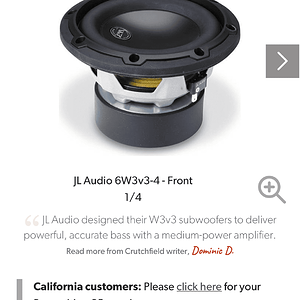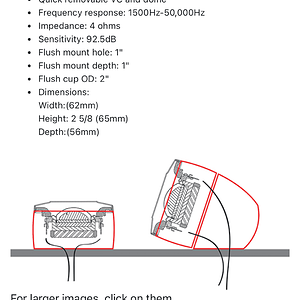VWBobby 10+ year member
PG and SS nuthugger
You are taking what I am saying out of context or splitting hairs with my statements.
I was talking about pushing your equipment to 75% or higher, not your "stereo". If you have a sub that can handle 1000W RMS, you are powering it with a 1200 or 1500RMS amp to have a little headroom, 750W RMS or higher would be 75% (of 1000W RMS). It has nothing to do with the amplifier. We are talking about subwoofers.
In my statement about Paper and Wool cones, I mention nothing about a Pulp reinforced cone. A pulp fiber cone is nowhere near as light as a paper or wool cones. Its almost similar to cardboard or MDF in materials....
Nice try, but anyone who can read between the lines isn't falling for it. //content.invisioncic.com/y282845/emoticons/wink.gif.608e3ea05f1a9f98611af0861652f8fb.gif As stated above, there are very few SQ oriented 15"+ subs in the car audio world, for a good reason. Most SQ subs have very high sensitivity (90DB or higher) and would require a huge box to perform optimally.
Just because the sub is round does not mean that the coil will not rock when the cone or suspension distorts. There are a lot of subs with tight gaps that will bind when/if the coil rubs. Coil rub is not always caused by a burnt or damaged coil. It can also happen from abused speakers. By that same token, it would be almost impossible for Kicker to keep their square subs aligned. The spider supports the upper half of the coil, the surround supports the upper half of the cone and keeps the coil perpendicular in the gap. Some high excursion subs even have 2 sets of spider landings to keep the coil centered in the gap. This is all to help prevent distortion, possible coil bind, or variations in the BL curve (coil not staying centered).
I was talking about pushing your equipment to 75% or higher, not your "stereo". If you have a sub that can handle 1000W RMS, you are powering it with a 1200 or 1500RMS amp to have a little headroom, 750W RMS or higher would be 75% (of 1000W RMS). It has nothing to do with the amplifier. We are talking about subwoofers.
In my statement about Paper and Wool cones, I mention nothing about a Pulp reinforced cone. A pulp fiber cone is nowhere near as light as a paper or wool cones. Its almost similar to cardboard or MDF in materials....
Nice try, but anyone who can read between the lines isn't falling for it. //content.invisioncic.com/y282845/emoticons/wink.gif.608e3ea05f1a9f98611af0861652f8fb.gif As stated above, there are very few SQ oriented 15"+ subs in the car audio world, for a good reason. Most SQ subs have very high sensitivity (90DB or higher) and would require a huge box to perform optimally.
Just because the sub is round does not mean that the coil will not rock when the cone or suspension distorts. There are a lot of subs with tight gaps that will bind when/if the coil rubs. Coil rub is not always caused by a burnt or damaged coil. It can also happen from abused speakers. By that same token, it would be almost impossible for Kicker to keep their square subs aligned. The spider supports the upper half of the coil, the surround supports the upper half of the cone and keeps the coil perpendicular in the gap. Some high excursion subs even have 2 sets of spider landings to keep the coil centered in the gap. This is all to help prevent distortion, possible coil bind, or variations in the BL curve (coil not staying centered).


